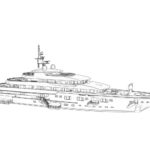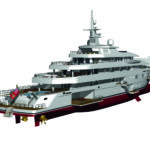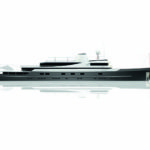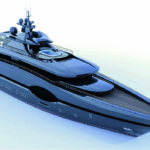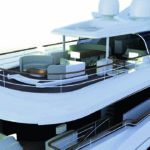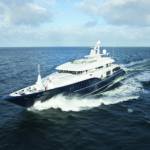Germany is well-known for its yards that build most of the world’s largest superyachts. But its maritime industry also hosts a handful of creative designers, writes Nick Jeffery
Ferdinand Porsche, Walter Gropius (the founder of Bauhaus), Dieter Rams (designing products for Braun), Peter Behrens (for AEG) and Ludwig[ds_preview] Mies van der Rohe (»God is in the details« and »less is more«) are all designer names associated with Germany. But, although German brands such as Blohm + Voss and Lürssen have built most of the largest superyachts afloat today, only a handful of German design studios are thriving in the world of superyacht design. British designers rank top in quantity of big projects, with Italian, French and Scandinavian designers winning many of the big design awards. Newcruise, Schnaase, Beiderbeck and V-Design are four names doing their bit in the world of superyacht design that might change that.
Newcruise, whose portfolio includes the 67 m »Triple Seven«, 73.5 m »Sapphire« (finalist of the World Superyacht Awards in 2012) and the 115 m explorer yacht »Luna«, is a force to be reckoned with. Founding partners Frank Neubelt and Roland Krueger and junior partner Katharina Raczek until recently operated with a team of naval architects, architects, product designers, illustrators, boat builders, interior architects and decorators out of impressively large riverside premises, bang on the waterfront of the Elbe river in Hamburg. »Ocean’s Eye« tops their list of dream projects to get the go-ahead on at present. Frank Neubelt has left, since our interviews, to set up Neubelt and Hansen Yacht Project in Hamburg.
Beiderbeck Designs of Bremen – the only one of the four studios not based in Hamburg – has been operating for 30 years, with Immo Luedeling and Tim Ulrich supporting the founder Jorg Beiderbeck. Their latest proposal is for an 80 m design with »timeless lines« but »modern in every detail«.
Behind the scenes, Jens Cruse of V-Design, situated on the Alster in Hamburg, specializes in virtual prototyping and complex surface modeling for the marine industry – with Lürssen, Abeking & Rasmussen, Blohm + Voss (»Lady Moura«), TKMS group, Platinum Yachts, and Hapag-Lloyd being clients. A 90 m superyacht project tops his wish list.
For interior design, Birgit Schnaase’s team has worked up designs for relatively smaller superyachts, airplanes, hotels, homes and commercial ships. »Angara«, a 41 m Horizon Yachts vessel, was finalist for a 2012 World Superyacht Award sporting a Schnaase interior.
Six questions were put to the design studios to see where they believe superyacht design is headed:
• Trends in superyacht design
• Exterior and hull trends
• New materials
• Energy efficiency
• Owner requirements
• Current »fashion« Replies were mixed:
• Newcruise believe there are two opposing trends with reduced design, plane surfaces with »sharp corners« and less opulent lines, function ruling and the vessel’s purpose guiding the task. Meanwhile, some clients still love recesses, projective overhangs and richness. Colour is certainly more bold in hull and superstructure. Beiderbeck say »bigger is better« and that there is no longer a requirement to cram maximum interior space into a certain length. Jens Cruse agreed size is increasing. He used to believe »Lady Moura« (105 m, delivered in 1990) was about as big as yachts would ever get but now wonders if he is right when he says they have now peaked. Birgit Schnaase points out that clients are opting to keep their current yachts longer so a trend is to opt for refit designs rather than new.
• Newcruise note the »Kreuzer« bow or negative bow, straight stems and Axe Bow trend, as well as »explorer« style. Beiderbeck say »funnels!« are in, as timeless and aesthetic lines are order of the day. Cruse points out the »S-shape sheer«, egg-shape wing stations and bathing platforms aft, also noting bows are getting more vertical – albeit meaning wetter foredecks. He believes hatches in the hull will increase and helipads are moving from aft to foredeck.
• Fibreglass is used in non-structural areas by Newcruise (on »777«, »Siren« and »Sapphire«) but steel and aluminium remains the norm for motor yachts, sail going more composite. In the interior Newcruise sees liquid metal or fabric structures »frozen« in resin to give new visual experiences as a trend. Beiderbeck agree composites are more ubiquitous than ever. Cruse believes steel will remain for hulls of displacement motor yachts but the use of carbon will be more widespread for planing motor yachts and sailing craft – all finished in high gloss.
• Energy efficiency is not a new topic since it is always considered, but Newcruise believe »range« is vital, without refueling so this is a focus. »Green« is a trend and fuel savings, environmental-friendly paint, new generation propulsion systems such as combustion cell are considered as is waste treatment – for autonomy at sea. Beiderbeck see LED lighting as a detail that is demanded frequently. Jens Cruse of V-Design believes hull shapes continue to improve thanks to CFD analysis, tank testing giving advantageous Froude numbers. He would like to see a really big sailing yacht built again, citing »the spirit of the times would make it just right«.
• Unique characteristics and a profile that is instantly recognized on the horizon, rather than series production, is what Newcruise believe owners want, as well as multi-purpose platforms that cater for vacation, private resort, chilling with guests or exploration, as well as charter. Schnaase predicts spas and healthy cuisine influencing design – yachts are expected to be better than hotels –, and with charter in mind personal taste is kept in check more than before. Beiderbeck underline that owners are looking at functionality more than some years ago and say they demand quality and high resale value from the outset of setting the brief. Cruse points out that there are only a few rich new owners, perhaps the next wave from China, but believes that Germany is the right place to come for whatever their requirements are.
• Fashion should perhaps be kept to the bits that are »easily refitted« but Newcruise see land-based design influencing superyacht interiors where clients want to »feel at home« and identify with their own space. Rooms are not »over-furnished« so much today, pieces being more freestanding with space to breathe. Beiderbeck jokingly say they are happy to see the back of the Axe Bow and are trying to predict the fashion of a few years time, when the next designs will be launched, while Jens Cruse – with a wink – sees »Phoenix 2« setting a trend for figureheads!
Superyachts and mass-produced products are far removed but superyacht designers could take note of what British designer, Jonathan Ive, credited with much of Apple’s product line, said about Dieter Rams – a major inspiration – designing: »surfaces that were without apology, bold, pure, perfectly-proportioned, coherent and effortless«, adding: »No part appeared to be either hidden or celebrated, just perfectly considered and completely appropriate in the hierarchy of the product’s details and features. At a glance, you knew exactly what it was and exactly how to use it.«
Most owners would likely say they want their yacht to be anything but unobtrusive but, putting tip number five aside, »Ten Tips from Dieter Rams for Good Design« might improve tomorrow’s superyachts, many of which will doubtless be made in Germany:
• Is innovative – The possibilities for innovation are not, by any means, exhausted. Technological development is always offering new opportunities for innovative design. But innovative design always develops in tandem with innovative technology, and can never be an end in itself.
• Makes a product useful – A product is bought to be used. It has to satisfy certain criteria, not only functional, but also psychological and aesthetic. Good design emphasizes the usefulness of a product whilst disregarding anything that could possibly detract from it.
• Is aesthetic – The aesthetic quality of a product is integral to its usefulness because products are used every day and have an effect on people and their well-being. Only well-executed objects can be beautiful.
• Makes a product understandable – It clarifies the product’s structure. Better still, it can make the product clearly express its function by making use of the user’s intuition. At best, it is self-explanatory.
• Is unobtrusive – Products fulfilling a purpose are like tools. They are neither decorative objects nor works of art. Their design should therefore be both neutral and restrained, to leave room for the user’s self-expression.
• Is honest – It does not make a product more innovative, powerful or valuable than it really is. It does not attempt to manipulate the consumer with promises that cannot be kept.
• Is long-lasting – It avoids being fashionable and therefore never appears antiquated. Unlike fashionable design, it lasts many years – even in today’s throwaway society.
• Is thorough down to the last detail – Nothing must be arbitrary or left to chance. Care and accuracy in the design process show respect towards the consumer.
• Is environmentally friendly – Design makes an important contribution to the preservation of the environment. It conserves resources and minimizes physical and visual pollution throughout the lifecycle of the product.
• Is as little design as possible – Less, but better; because it concentrates on the essential aspects, and the products are not burdened with non-essentials. Back to purity, back to simplicity.
Dieter Rams said last year: »I am troubled by the devaluing of the word ›design‹. I find myself now being somewhat embarrassed to be called a designer. In fact I prefer the German term, Gestalt-Ingenieur.« Perhaps embarrassment is why Germany’s superyacht »designers« are mostly modestly hidden behind the scenes in the builders’ large, purposeful in-house engineering departments?
Author: Nick Jeffery Yacht Publicity, Monaco info@nickjeffery.com
Nick Jeffery







